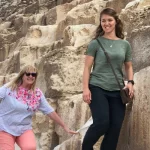Culture of Ancient Egypt:
1- Religious Life
For the ancient Egyptians, the universe was composed of dualities – fertile and barren, life and death, order and chaos – held in a state of equilibrium by the goddess Maat. To maintain this balance they built enormous temples dedicated to the gods.
2- Hieroglyphs
Hieroglyph means “sacred carved letter” and refers to the beautiful pictorial script used by the ancient Egyptians. Hieroglyphs can convey complex information. They can be read right to left, left to right or top to bottom.
3- The Cult Temple
At the center of every settlement was a cult temple. These temples served as a storehouse of divine power, maintained by the priests. The temple was also an economic and political centre employing large numbers of the local community and serving as a town hall, medical centre and college.
4- The Mortuary Temple
In addition to the local cult temples, each pharaoh also built a mortuary temple to serve as a place where, following his death, offerings could be made for his soul. In the Old and Middle Kingdoms the temples were attached to tombs but by around 1500 BC the tombs were separate and hidden away to foil robbers.
5- Burial Traditions
The ancient Egyptians believed in an eternal afterlife and they developed a complex funerary cult aimed at maintaining their life after death. This involved preserving the body through a process of mummification. The tombs of the deceased were also stocked with everything that might be needed in the afterlife.
6- Mummification
The earliest mummies were probably accidental. True mummification began in the Fourth Dynasty. Special priests first removed the internal organs, which were stored in canopic jars, except for the heart, which remained in place to be weighed in the afterlife. Then the corpse was dried out and wrapped in linen.
7- Tomb Paintings
As a guarantee against a successful journey into the afterlife, ritual images and texts were used to decorate the tomb. These included scenes from the Book of the Dead, which contained instructions to help the deceased to pass safely through obstacles in the afterlife.
8- Mythology
Ancient Egyptian religion was a complex belief system involving a great number of deities originally based on aspects of the natural world. Over time different localities developed many and varied myths relating to their own deities.
9- The Creation Myth
In the beginning there was nothing but the sea of chaos, named Nun. Then Atum thought himself into being, sneezing to create Shu and Tefnut. Shu and Tefnut gave birth to two children: Geb, the earth, and Nut, the sky, who in turn gave birth to the stars.
10- Osiris and Isis
Osiris was murdered by his jealous brother Seth, who cut up the body scattering it all over Egypt. Osiris’s wife Isis collected up the pieces and put him back together again as the first mummy. Brought back to life, Osiris became lord and judge of the dead.
Book your Travel Package now to know more about Egypt history





